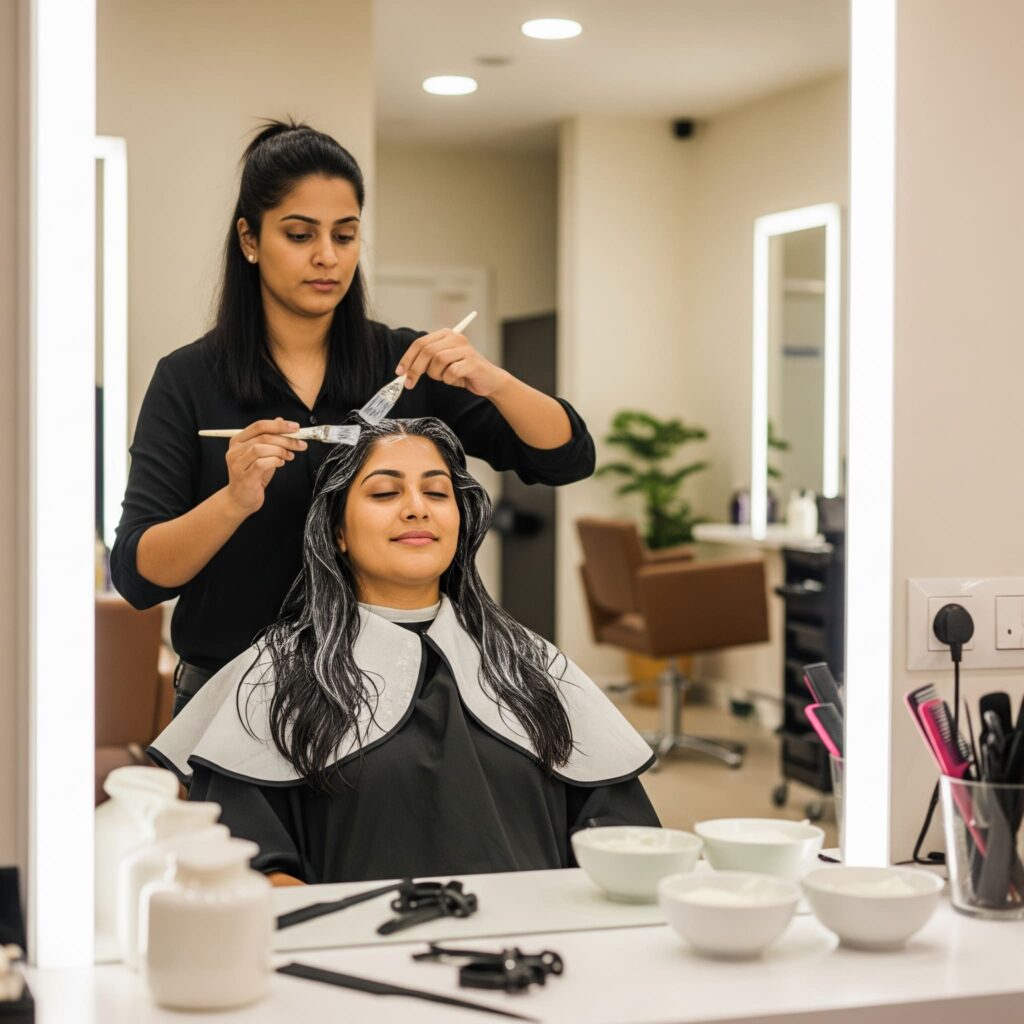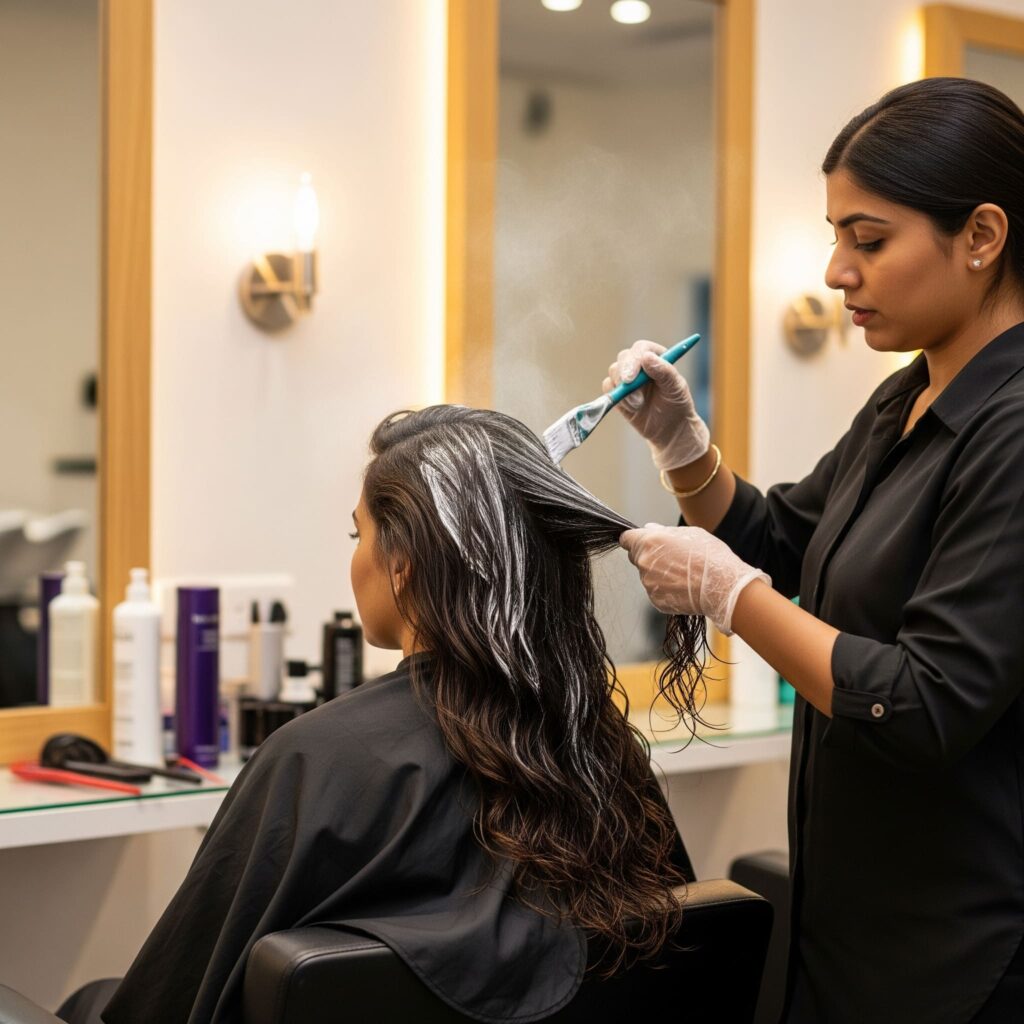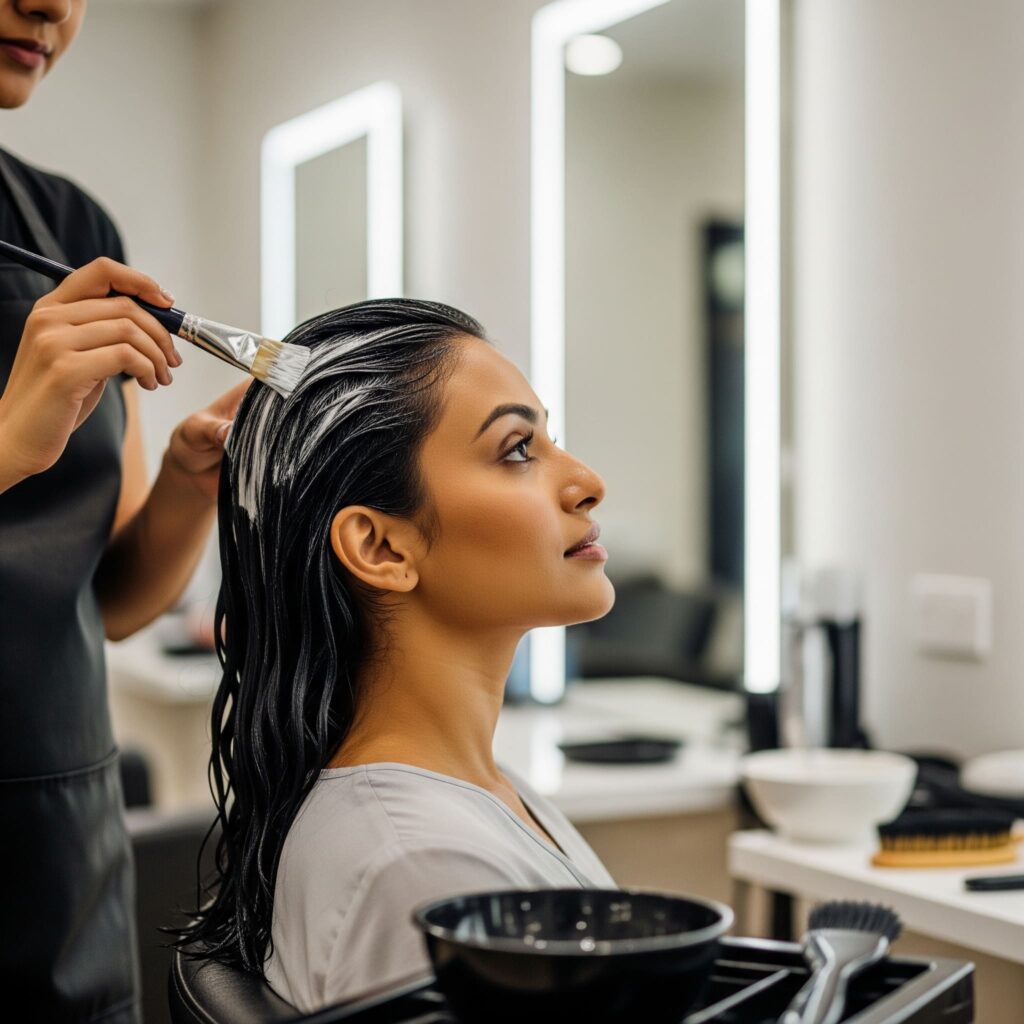Cysteine and hair botox are both hair treatments that aim to improve hair health and appearance, but they differ in their approach and primary benefits. Cysteine is a protein-based treatment that focuses on restructuring hair bonds for smoother, straighter, and frizz-free hair, while hair botox is a deep conditioning treatment that repairs damaged hair and provides shine and smoothness.
If you’re exploring solutions for frizz, damage, or thin hair, the choice of Cysteine vs Hair Botox treatments is important. When comparing Cysteine vs Hair Botox, both aim to restore smoothness and vitality but use different techniques. Many wonder about cysteine hair treatment, hair botox, and the side effects involved in the Cysteine vs Hair Botox debate. This guide will help you understand the benefits, application methods, and aftercare to make the best decision for your hair needs.
Table of Contents
What is Cysteine Hair Treatment?
A cysteine hair treatment is a keratin-based smoothing process that uses the amino acid cysteine to penetrate the hair shaft, reconstruct damaged bonds, and reduce frizz. When comparing Cysteine vs Hair Botox, many find cysteine treatments offer a gentler approach focused on nourishing and strengthening hair strands. Unlike traditional chemical straightening, the Cysteine vs Hair Botox debate often highlights cysteine as a milder alternative that smoothens hair fibers while enhancing shine. For those looking to repair damaged hair, understanding the differences in Cysteine vs Hair Botox can help choose the best treatment for hair repair and lasting smoothness.

Advantages of Cysteine Hair Treatment
Advantages of Cysteine Hair Treatment include smoother, frizz-free hair with improved strength and shine. When comparing Cysteine vs Hair Botox, many prefer cysteine treatment for its natural protein-based formula that deeply nourishes the hair without harsh chemicals. The debate of Cysteine vs Hair Botox often highlights cysteine’s longer-lasting effects and its ability to restore damaged hair more effectively. Another key point in the Cysteine vs Hair Botox discussion is cysteine’s suitability for various hair types, making it a versatile choice among hair treatments.
- Frizz reduction: Makes hair smoother and more manageable.
- Hair strength: Rebuilds disulfide bonds inside hair fibers to reinforce strands.
- Natural look: Maintains volume and texture without overly stiff results.
- Less chemical damage: Uses gentler chemistry compared to traditional keratin treatments.
- Suitable for sensitive scalps due to milder formula.
- Improves shine and softness for a healthier appearance.
How Does the Cysteine Treatment Work?
Cysteine treatment involves applying a solution containing cysteine and other natural ingredients to clean, damp hair. When comparing Cysteine vs Hair Botox, the cysteine solution penetrates the cuticle and cortex, repairing the internal hair structure. The hair is then blow-dried and flat-ironed to seal the treatment. This heat activation locks in smoothness while maintaining hair’s natural bounce. In the debate of Cysteine vs Hair Botox, cysteine treatment offers a more natural way to rejuvenate hair without heavy chemicals. Many clients choose cysteine for its strength and shine benefits, making it a preferred option in the Cysteine vs Hair Botox comparison.

Side Effects of Cysteine Hair Treatment
When considering Cysteine Hair Treatment Side Effects, many people also compare the treatment with other options like Cysteine vs Hair Botox. Understanding the differences in potential side effects between these treatments is crucial before making a decision. While both procedures aim to improve hair texture and reduce frizz, the Cysteine vs Hair Botox debate often centers on their safety profiles and how each may affect hair health over time. Being informed about the common side effects associated with cysteine treatments as well as how they compare to hair botox can help you choose the best option for your hair type.
- Potential dryness if heat used excessively
- Mild scalp irritation in sensitive individuals
- Overprocessing may cause breakage if done too frequently
Explore different types of hair treatments to find your perfect hair care solution.
What is Hair Botox?
Hair botox is a deep conditioning treatment designed to repair damaged, thin, or aging hair by filling in gaps in the hair fibers with a blend of vitamins, amino acids, proteins, and antioxidants. When comparing Cysteine vs Hair Botox, it’s important to note that hair botox does not contain botulinum toxin but gets its name from its restorative effects. Many people wonder about the benefits and differences of Cysteine vs Hair Botox treatments for hair repair. Overall, Cysteine vs Hair Botox offers a non-invasive solution to improve hair health by deeply nourishing and smoothing the strands.

Advantages of Hair Botox
Advantages of Hair Botox include deep nourishment, frizz control, and enhanced hair smoothness. When comparing Cysteine vs Hair Botox, many prefer Hair Botox because it repairs damaged hair while adding volume and shine without harsh chemicals. Unlike some treatments, the benefits of Cysteine vs Hair Botox show in the softness and manageability of hair over time. Choosing between Cysteine vs Hair Botox depends on your hair type, but Hair Botox stands out for providing a lightweight, rejuvenating effect that strengthens hair fibers and reduces breakage.
- Repairs damaged hair by replenishing protein and moisture.
- Reduces hair fall improving hair density and strength.
- Restores elasticity and softness for youthful-looking hair.
- Suitable for botox treatment for thin hair boosting volume and health.
- Non-chemical, free from formaldehyde, making it safer for sensitive hair and scalp.
- Enhances shine and smoothness without altering hair structure permanently.
How Does the Hair Botox Treatment Work?
Hair botox treatment is applied as a mask to the shampooed hair, coating each strand to fill in damage and hydrate deeply. When comparing Cysteine vs Hair Botox, it’s important to note that the botox formula penetrates the hair cuticle with a rich blend of amino acids, collagen, and vitamins. Unlike cysteine treatments, the Cysteine vs Hair Botox debate often highlights how hair botox nourishes and repairs hair without harsh chemicals. After letting it absorb, the hair is blow-dried and flat-ironed, locking the nutrients inside for lasting softness, which is a key point in the Cysteine vs Hair Botox comparison.
Side Effects of Hair Botox Treatment
Hair Botox Treatment Side Effects are generally minimal when performed by a professional, but it is important to understand the differences when comparing treatments like Cysteine vs Hair Botox. While Hair Botox helps restore damaged hair by filling in gaps and smoothing frizz, many people wonder how it stacks up against cysteine-based treatments. When evaluating Cysteine vs Hair Botox, some side effects such as scalp irritation or allergic reactions may occur, though they are rare. It is essential to consult with a stylist to determine which option suits your hair type best, especially when considering the potential side effects of Cysteine vs Hair Botox treatments.
- Scalp tingling or irritation in rare cases
- Temporary weigh-down or greasiness if product buildup occurs
- Very low risk compared to chemical straighteners
Both treatments benefit from being administered by professionals to minimize risk and maximize results. Compare gel nails vs acrylic nails to find the best nail option!

Major Differences Between Hair Botox and Cysteine Hair Treatment
When comparing Cysteine vs Hair Botox, it’s important to understand that both treatments target hair smoothing and repair but work with different ingredients and processes. Cysteine vs Hair Botox treatments differ primarily in their composition; cysteine treatment uses the amino acid cysteine which naturally occurs in hair, whereas hair Botox is a protein-rich formula designed to coat and fill in damaged hair. Choosing between Cysteine vs Hair Botox depends on your hair type, desired results, and sensitivity to chemicals, as both offer smooth, shiny hair but with varying longevity and effects.
| Feature | Cysteine Hair Treatment | Hair Botox Treatment |
| Main Ingredient | Amino acid cysteine | Proteins, vitamins, antioxidants |
| Purpose | Smoothing, repairing, straightening hair | Deep conditioning, repairing damaged hair |
| Effect Duration | 2–4 months | 1–3 months |
| Chemical Process | Mildly chemical with heat activation | Non-chemical; conditioning mask |
| Hair Type Suitability | Frizzy, coarse, damaged | Thin, aging, dry or chemically treated hair |
| Results | Reduced frizz, smooth hair with volume preserved | Restored softness, enhanced shine and elasticity |
| Side Effects | Possible dryness if heat applied improperly | Minimal; rare scalp sensitivity |
Discover the key differences and best choice between Balayage vs Ombre styles.
Tips to Follow After Hair Botox and Cysteine Hair Treatments
When comparing Cysteine vs Hair Botox, it’s important to understand how each treatment affects your hair’s health. After your session, whether it’s Cysteine vs Hair Botox, make sure to avoid washing your hair for at least 48 hours to maximize the results. Additionally, following the right care routine based on the differences in Cysteine vs Hair Botox treatments can help maintain smooth, silky hair for longer.
- Avoid washing hair for at least 48–72 hours post-treatment to let formula set fully
- Use sulfate-free and gentle shampoos to preserve treatment effects
- Minimize heat styling to reduce damage and prolong results
- Avoid chlorine and saltwater exposure or use protective sprays when swimming
- Regularly moisturize and nourish hair with recommended conditioners and oils
Compare cysteine hair treatment vs keratin hair treatment to choose the best!
Conclusion
Choosing between Cysteine vs Hair Botox depends on your hair’s condition and goals. Cysteine treatment is ideal for those seeking frizz control and smoothness with minimal chemical impact, especially for cysteine treatment for frizzy hair. When considering Cysteine vs Hair Botox, hair botox offers deep nourishment and strength, making it a great restorative treatment for botox treatment for thin hair looking to regain volume and softness. Understanding the benefits of Cysteine vs Hair Botox, along with possible cysteine hair treatment side effects versus the advantages and minimal risks of hair botox, empowers you to select the treatment aligned with your hair needs. Always consult professionals to ensure safety and personalized care.
For personalized Cysteine Treatment and Hair Botox advice tailored to your unique hair needs, visit Peacock Salon in Vashi, Navi Mumbai. Our skilled stylists specialize in healthy, results-driven Cysteine Treatment and Hair Botox services. Find us at Mahavir Center, Shop No. 20, 21, 21A, 22, next to Golden Punjab Hotel, Sector 17, Vashi or call +91 9324774567 to book your consultation and rejuvenate your hair care routine.
Cysteine vs Hair Botox – FAQs
What is cysteine hair treatment?
It’s a keratin-based smoothing treatment using amino acid cysteine to reduce frizz, rebuild hair bonds, and enhance shine.
What is the difference between hair botox treatment and cysteine treatment?
Cysteine primarily smooths and straightens hair mildly chemically, hair botox deeply conditions and repairs with vitamins and proteins without chemicals.
What are the benefits of cysteine hair treatment?
It reduces frizz, strengthens hair, maintains volume, and improves softness with less chemical damage.
What are the side effects of cysteine hair treatment?
Mild dryness, scalp irritation, or breakage if overused or heat is applied incorrectly.
What is hair botox treatment for thin hair?
A nourishing treatment that restores volume, softness, and strength to thinning or damaged hair.
What are the advantages of hair botox?
Deep repair, moisture retention, improved elasticity, and shine without harsh chemicals.
Does hair botox treatment have side effects?
Side effects are rare and include slight scalp irritation or temporary buildup from product residue.
How does cysteine treatment work?
It penetrates hair strands with cysteine and heat to restructure bonds, smooth, and soften hair.
Is hair botox treatment safe for sensitive scalps?
Yes, hair botox is generally safe due to its non-chemical formula and moisturizing properties.
Can cysteine and hair botox treatments be combined?
It’s best to consult a hair professional; usually, one treatment at a time is recommended to avoid overprocessing.
